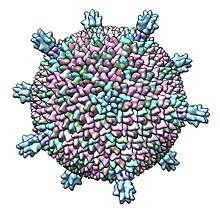Sulfolobus turreted icosahedral virus 1
Sulfolobus turreted icosahedral virus 1 (formerly Sulfolobus turreted icosahedral virus) is a species of virus that infects the archaeon Sulfolobus solfataricus.[2][3][4]
| Sulfolobus turreted icosahedral virus 1 | |
|---|---|
 | |
| 4.5 Å structure of Sulfolobus Turreted Icosahedral Virus 1 determined by cryoEM. EMDB entry EMD-1569, PDB entry 3j31.[1] | |
| Virus classification | |
| (unranked): | Virus |
| Realm: | Varidnaviria |
| Kingdom: | Bamfordvirae |
| Phylum: | Preplasmiviricota |
| Class: | Tectiliviricetes |
| Order: | Belfryvirales |
| Family: | Turriviridae |
| Genus: | Alphaturrivirus |
| Species: | Sulfolobus turreted icosahedral virus 1 |
History
This virus was isolated from a hot spring in the Rabbit Creek thermal area which is located in the Midway Geyser Basin of Yellowstone National Park.[5]
Virology
It is an icosahedrally symmetric virus with a unique triangulation number (T) of 31. At the 12 fivefold symmetrical positions of the icosahedron protrude 'turrets' that extend 13 nanometers (nm) above the capsid surface. The turrets have an average diameter of 24 nm. The center of each turret contains a ~3-nm channel. The function of this channel is not known but it may provide access between the interior and exterior of the virion. There appears to be a density at each end of the channel indicating that the channel may be blocked and suggesting a possible regulatory role associated with this density.
There are five structural proteins: a major protein of 37 kiloDaltons (kDa) and several minor proteins with estimated masses of 75, 25, 12.5 and 10 kDa. The major capsid protein is predominantly β-sheeted.
The genome is circular double stranded DNA 17.663 kilobases in length with 36 open reading frames. The genome has a G+C content of 36%.
Unlike other viruses that either lyse or bud from their hosts this virus induces a unique pyramid-like structure on the surface of the host from which it buds.
References
- Veesler, D.; Ng, T. -S.; Sendamarai, A. K.; Eilers, B. J.; Lawrence, C. M.; Lok, S. -M.; Young, M. J.; Johnson, J. E.; Fu, C. -Y. (2013). "Atomic structure of the 75 MDa extremophile Sulfolobus turreted icosahedral virus determined by CryoEM and X-ray crystallography". Proceedings of the National Academy of Sciences. 110 (14): 5504–5509. doi:10.1073/pnas.1300601110. PMC 3619359. PMID 23520050.
- ICTV proposals 2013.002a-gB et al., "Create the family Turriviridae, comprising the new genus, Alphaturrivirus, and two new species", Mark Young et al.
- Virus Taxonomy: 2014 Release, International Committee on Taxonomy of Viruses. Accessed on line Nov. 25, 2015.
- Happonen, L. J.; Redder, P; Peng, X; Reigstad, L. J.; Prangishvili, D; Butcher, S. J. (2010). "Familial Relationships in Hyperthermo- and Acidophilic Archaeal Viruses". Journal of Virology. 84 (9): 4747–4754. doi:10.1128/JVI.02156-09. PMC 2863766. PMID 20164227..
- Rice, G. (2004). "The structure of a thermophilic archaeal virus shows a double-stranded DNA viral capsid type that spans all domains of life". Proceedings of the National Academy of Sciences. 101 (20): 7716–7720. doi:10.1073/pnas.0401773101. PMC 419672. PMID 15123802.